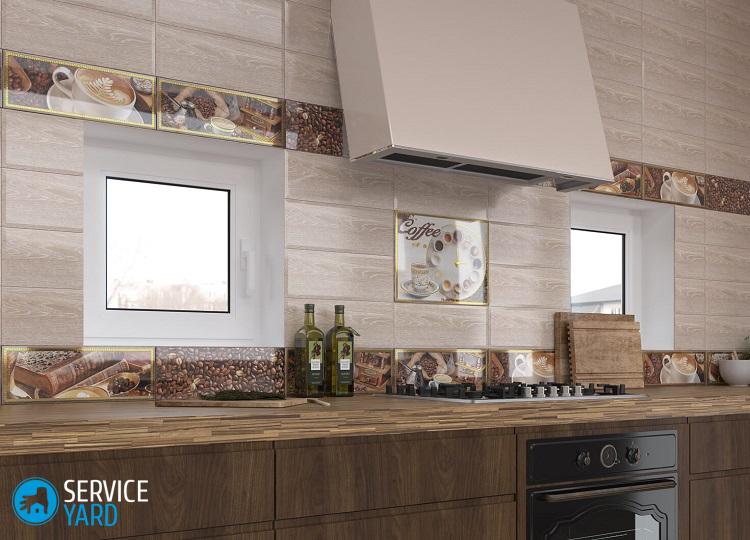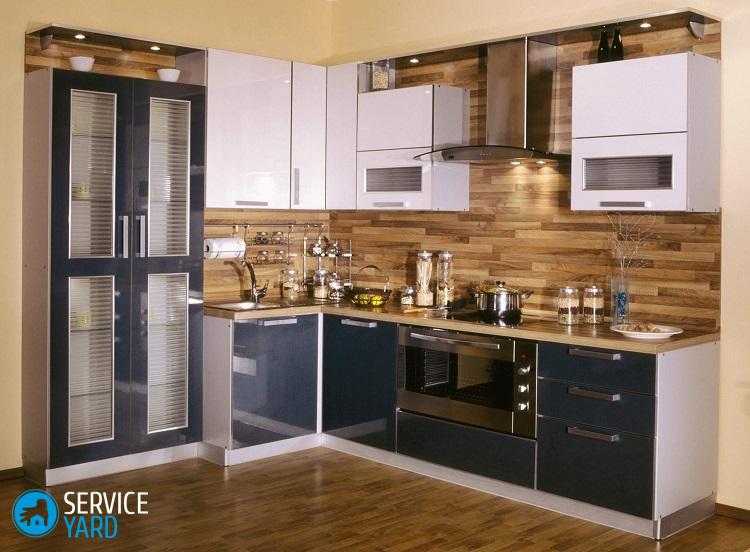Kitchen apron

A beautiful, elegant and at the same time practical kitchen apron is an indispensable element of the design of a modern kitchen. This is part of the wall between the floor furniture and hanging cabinets, and it is it that is most susceptible to pollution, so the requirements for materials here are very special. An apron is only considered successful when it pleases the eye and is easy to keep clean. What design options are possible - we will consider in detail in this article.
to contents ↑Materials of manufacture
Until relatively recently, hardly anyone thought about how to better equip kitchen aprons for the kitchen on the wall:
- The surface was simply painted with oil paint.
- There was another option, not too practical: the walls were glued with wallpaper, which was then varnished.
- The most luxurious option was considered tile.
Today, the choice of materials is much more extensive. The option with the usual ceramic tiles has not lost its relevance, but there are other types of practical and inexpensive materials:
- Mosaic.
- High-strength glass with a pattern.
- Plastic.
- A rock.
- MDF.
- Porcelain tile and other derivatives of natural stone.
Dimensions
As for the length, there are no questions with it. But the height of the apron on the wall for the kitchen should be somewhat larger than the open space. The bottom of the finish goes to the floor tables, and the top - to the hanging cabinets. The size of the stock is about 50, much depends on what size of the finish (for example, tiles) you use.
Since there are no hanging cabinets above the stove, the cladding in this place is higher. All this is for reasons of convenience. Cleaning is much easier. Now consider what are the aprons for the kitchen on the wall.
to contents ↑Important! Think in advance about the location of household appliances in the kitchen. You may find our tips useful how to make apron sockets.
Ceramic tile
To date, she managed to become a kind of classic of the genre. It is washed very easily, the service life is quite long. A huge range of sizes, shapes, textures and shades allows you to implement a variety of design options.
Tiles also have disadvantages:
- The high cost of materials and installation work.
- The complexity of quality installation.
- A large number of seams and the need for grouting. This is especially true for small tiles. At the same time, it is the seams that quickly get dirty. It is necessary to remove the old grout and apply a new one.
The shape of ceramics can be different. Recently, a cladding of a rectangular shape (the so-called “hogs”) is common. Sizes are also different. A large coating with a side size of 0.6-0.7 m is very practical - there are much fewer seams.
Complex forms
A good solution is non-linear cladding of a complex configuration. Such material costs much more than a linear wall covering. At the same time, you need to buy it with about 10 percent margin. This is a reserve for battle during transportation and waste during cutting.
Important! It should also be taken into account that, perhaps, over time, the cladding will have to be repaired. It’s necessary to leave a reserve of several tiles, since even the most popular collections are discontinued very quickly. Updating collections in modern stores is lightning fast.
Mosaic
A special case of facing ceramic material is a mosaic, from which, if desired, you can lay out a real picture-panel. Of course, laying takes a lot of time, but the result is amazing.
Important! Choosing ceramics as the main material in any of its formats, browse our overview of the best collections and manufacturers of tiles.
Modules
Ready-made options are available for sale - a grid with tiles fixed to it. It is enough to lay the grid on the mortar and rub the seams. The lining is ready.
to contents ↑Important! Ceramics with prints on it are also popular. This can be either a photo or a picture. For example, in the kitchen, the image of vegetables, flowers, and fruits is appropriate.
Glass
This material began to be used on working kitchen walls relatively recently. However, glass wall decoration is gaining in popularity:
- Care is much simpler than for ceramics.
- The surface is completely smooth, no seams.
- A drawing can be applied to almost anything - from photos to graphics. Three-dimensional images look beautiful.
DIY photo printing on glass
The high cost of the glass facade is largely due to the fact that the technology of applying a pattern to glass is a rather time-consuming task. You can get out of the situation if you apply the image to the glass yourself. Of course, the technology is different from the factory, but the home craftsman can’t be scared of difficulties. That's why he is a craftsman:
- The “skinal” technique involves the use of two relatively thin glasses. It’s great if the glasses are tempered, but also ordinary, as practice shows, serve very well.
- Holes for fasteners are drilled in the lining.
- A film with an image is glued onto a previously prepared surface, and the top is covered with another glass.
A beautiful apron for the kitchen is ready!
Important! Both glasses should be the same in size. The holes for the fasteners must also match.
It remains to fix the finished apron on the wall. For better moisture protection, the joint along the entire length is coated with a silicone-based sealant. Do not use acrylic sealant, as it changes color over time.
to contents ↑Important! You can do without a second glass, but the likelihood of rapid contamination of the picture. And if you plan to save on the design of this part of the kitchen space, use our step-by-step instructions to make an apron and glass with your own hands.
LDSP, MDF
This option is for those who want to quickly and inexpensively draw up a work wall in the kitchen. Plywood and particleboard need to choose durable, with a moisture resistant coating. The cost of a dense material is higher, but such a wall will last quite a long time.
The panels are mounted using self-tapping screws or dowels-nails. Before installing the apron, it is smeared with adhesive on the back. It turns out a great addition to fasteners. Corners can be decorated with plastic or aluminum corners. Which option to choose depends on the style in which the kitchen furniture is designed.
Important! Color can be different - imitation of wood, stone, various drawings, photo printing, etc.
The film is glued onto the surface of the MDF. Since it must be waterproof and dense, such material is expensive.
to contents ↑Important! For detailed step-by-step master classes on installing such material, see the article “Installing an MDF apron in the kitchen”.
Plastic - an inexpensive and beautiful kitchen apron
The main advantage of plastic is ease of installation and operation, low cost. Plastic is easy to keep clean and resistant to even the most aggressive household chemicals. Plastic has a wide temperature range - from -40 to 90 degrees.
Important! The only minus of plastic is that it does not tolerate solar radiation very well.
to contents ↑Important! Plastic panels are mounted on "liquid nails", applied pointwise.If you need more detailed instructions, click on the link to the article in which we described the whole process step by step plastic apron mounts.
Stone, metal
A stone apron for the kitchen is a rarity. A stone surface is expensive, and it’s difficult to take care of it: dirt clogs into the pores of the material. Much easier to care material based on stone - granite. It can be very smooth, so it’s easier to wash. In addition, stone panels are heavy, so installation is a known complication.
The use of metal to decorate the working wall also happens infrequently. Metal is appropriate in Hi-tech or Minimalism design, but designers will have to work hard so that the kitchen does not resemble a meat-cutting shop.
to contents ↑Stock footage
As you can see, there are many options for aprons for the kitchen for all tastes and financial possibilities. Choose and create a unique dream design!




















